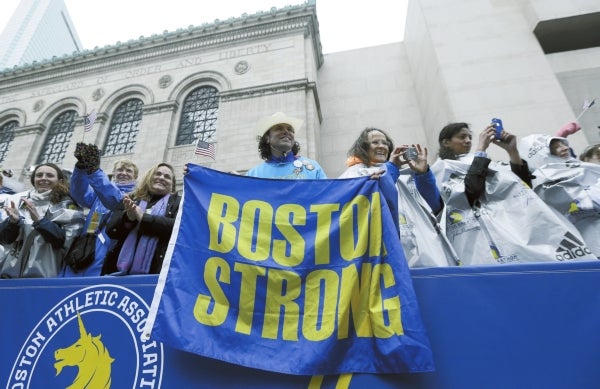Boston again has local flavor as the city and runners take back their marathon
Published 12:00 am Tuesday, April 21, 2015

- Carlos Arredondo, a 2013 Boston Marathon first-responder, holds a "Boston Strong" banner beside his wife Melida, right, in the grandstand near the Boston Marathon finish line Monday, April 20, 2015 in Boston. (AP Photo/Elise Amendola)
Weather conditions at the 119th running of the Boston Marathon were tough on the runners, though still better than expected.
A headwind of up to 30 miles per hour and a steady rain were predicted, along with temperatures in the mid-40s. Marathon runners are usually happy with that temperature anytime, but running into a strong headwind, plus the effects of a steady rain, usually make for a bad experience.
The Boston Marathon is the only major marathon where the starting field is filled by qualifying times based on age and gender. All entrants have to run another marathon or an exceptional race at a shorter distance to gain entry.
This year’s event had about 30,000 competitors, including wheelchair racers and several wave starts. Always held on Patriot’s Day, the marathon is run on a direct course from Hopkinton, Mass., to downtown Boston — and the famed finish on Boylston Street in Copley.
Security remained heavy, though less intrusive this year, in the aftermath of the 2013 bombing, with even police and National Guard soldiers often applauding the efforts of some of the world’s best runners.
Local competitors included Adam Cornelius of Rockwell, and Dr. Kathi Russo, Carol Hauss andDr. Victor Rosado, all of Salisbury. All are Boston veterans, though Rosado returned after a 31-year absence. Cornelius, Russo and Hauss all competed in the 2013 event.
The race was again dominated by Kenyans and Ethiopians, though Americans did better than usual. The men’s winner was Ethiopia’s Lelisa Desisa in 2 hours, 9 minutes and 17 seconds. He broke from a pack of 10 runners, gradually pulling away to a 31-second win. Dathan Ritzenhein and Meb Keflezighi led the Americans in seventh and eighth place, respectively.
Keflezighi, last year’s winner, wrote the names of the bombing victims on his race number today. He said, “People were cheering, saying ‘U.S.A.’ I was chanting with them as I finished with tears in my eyes.”
The women’s race came down to a one-mile sprint that netted Kenyan Caroline Rotich a four-second win in 2:24:55. Americans Desiree Linden and Shalane Flannigan were fourth and ninth.
Cornelius led the local runners with a time of 3:01:23, Russo followed in 3:37:21, Rosado in 3:47:05, and Hauss in 4:00:04.
“The marathon went pretty well. The hills got me again, but I was able to bounce back after Heartbreak Hill. I’m very happy,” said Cornelius. “Conditions were a little rough. After the race, I was shaking uncontrollably. The thing about Boston is that it doesn’t matter about the conditions. It is just anincredible experience. I will be back next year.”
Cornelius works with his dad at Charles Cornelius Construction, and jokes that this work serves as his cross training. Rosado, a local psychiatrist, said, “I feel blessed to remain healthy long enough to compete in Boston again after 31 years. I won’t wait as long for the next one.”
Russo had her fastest time yet at Boston, regardless of today’s conditions. Hauss, a Novant Health employee, completed her seventh Boston Marathon.
“I had a really good day running,” said Hauss. “We were expecting the weather to be worse but it was much better than predicted.”
The Boston Marathon is one of those sporting events that I try not to miss. I only ran four of them, but most other years find me in front of the TV, remembering the sights and sounds of the world’s most famous road race.
The race course was first designed to follow the train tracks along the whole route, and I just learned today that the race officials had such a small field in the early years that they rode the train instead of all the cars, trucks and motorcycles that they use now. The train would go from town to town, ahead of the runners and after the officials hopped off to time the entrants as they passed by, back on the train they went to hurry on to the next town.
The course itself is mostly downhill or flat for the first 13 miles, then it passes through a series of climbs called the “Heartbreak Hills,” as the elevation recovers before gradually descending back into Boston. It is estimated that two million people line the course along the 26.2 miles, though it looked to me that today’s crowd was held down some by the weather.
I asked Carol what made this Boston stand out ahead of the others and she said, “Boston is still so strong! The crowd, especially as we got nearer to the city, was loud and so supportive. Last year, the National Guard was out and focused on the crowd as the course was pretty much on lockdown. This year, the runners were told to enjoy the race experience and to smile often. That is exactly what we did. Those soldiers actually took some time to applaud the runners and chat with the spectators.”
I also heard today that athlos, root of the noun athlete, is Greek for struggle or battle.
Our local runners and thousands of other athletes did battle today, each fulfilling a dream long-desired. But they did much more than that. The large crowd of runners and the city of Boston made a huge step forward toward reclaiming their marathon.





